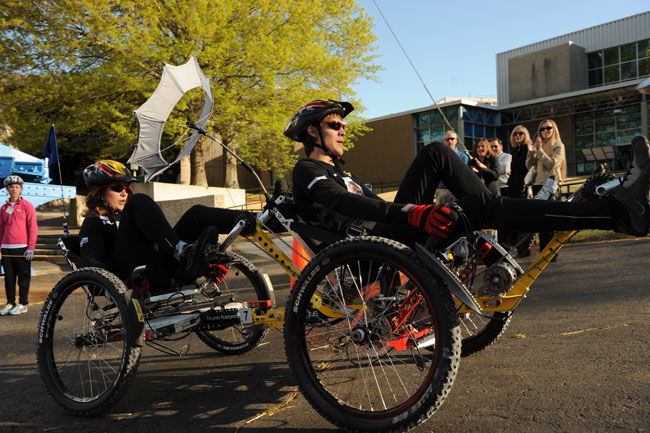Mock Moon Buggies From Germany, Puerto Rico Win NASA Race

Two veteran contenders maneuvered their way to victoryaround twisting curves, treacherous gravel pits and other obstacles in a NASAcontest that simulated race across the moon's surface
The team representing the International Space EducationInstitute of Leipzig, Germany, won the high school division, while racers fromthe University of Puerto Rico in Humacao took first place in the collegedivision of NASA's 17th annual Great MoonbuggyRace.
The winning competitors beat out more than 70 teams from 18states, Puerto Rico, Canada, Germany, India and Romania.
More than 600 drivers, engineers and mechanics — allstudents — gathered with their team advisors and cheering sections to take partin the matchup of wits and wheels at the two-day event, which began April 9 atU.S. Space & Rocket Center in Huntsville, Ala.
The annual race is organized by NASA's MarshallSpace Flight Center in Huntsville, and challenges students to design, buildand race lightweight, human-powered buggies that have to tackle many of thesame engineering challenges that Apollo-eralunar rover developers faced at the Marshall Center in the late 1960s.
The International Space Education Institute has been aprominent contender in the moonbuggy competition ever since they debuted in2007 as the German Space Education Institute. The team this year included twoRussian students, reflecting the school's expanded international scope.
The University of Puerto Rico in Humacao is the only schoolin the world to enter a moonbuggy in every race since the race was founded in1994. The team finished in second place in 2009 and finally captured firstprize this year in their 17th appearance.
Get the Space.com Newsletter
Breaking space news, the latest updates on rocket launches, skywatching events and more!
The winning teams posted the fastest vehicle assembly andrace times in their divisions, in addition to recording the fewest on-coursepenalties. The International Space Education Institute posted a speedy time of3 minutes and 37 seconds. The University of Puerto Rico at Humacao posted atime of 4 minutes and 18 seconds.
- Images— Visions of Future Moon Bases
- SpecialReport — THE MOON: Then, Now, Next
- New PhotosReveal Apollo 11 at First Moon Landing Site
Join our Space Forums to keep talking space on the latest missions, night sky and more! And if you have a news tip, correction or comment, let us know at: community@space.com.

Space.com is the premier source of space exploration, innovation and astronomy news, chronicling (and celebrating) humanity's ongoing expansion across the final frontier. Originally founded in 1999, Space.com is, and always has been, the passion of writers and editors who are space fans and also trained journalists. Our current news team consists of Editor-in-Chief Tariq Malik; Editor Hanneke Weitering, Senior Space Writer Mike Wall; Senior Writer Meghan Bartels; Senior Writer Chelsea Gohd, Senior Writer Tereza Pultarova and Staff Writer Alexander Cox, focusing on e-commerce. Senior Producer Steve Spaleta oversees our space videos, with Diana Whitcroft as our Social Media Editor.









